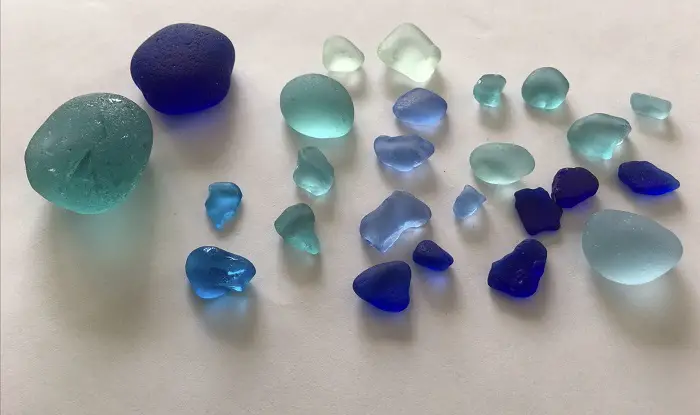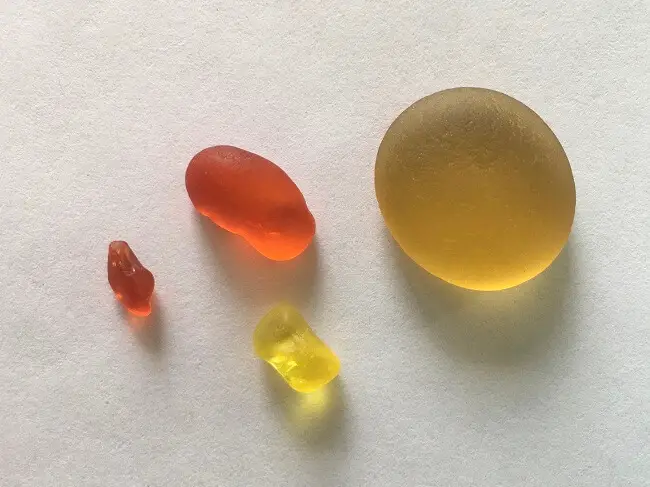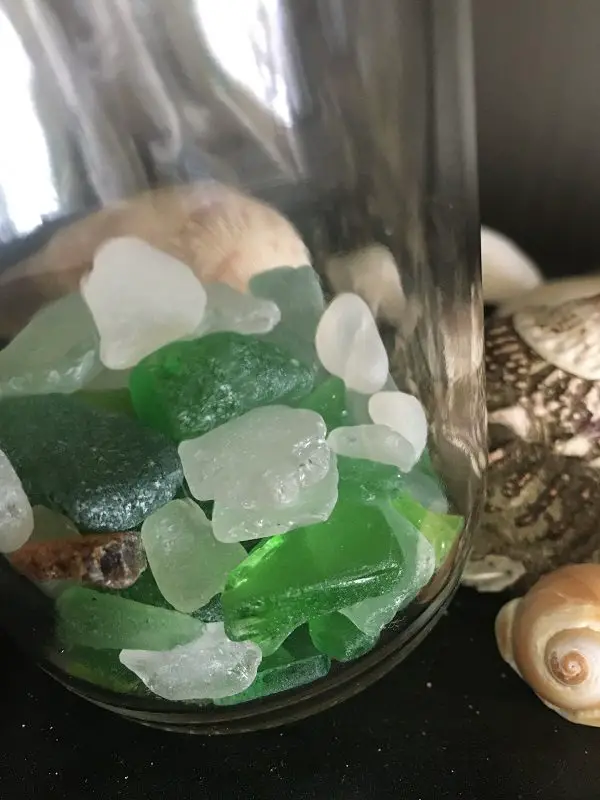San Diego Xeriscape Gardens: Beautiful & Water-Wise!
Since we live in such a dry climate, San Diego xeriscape practices include carefully crafting our outdoor spaces to minimize water usage while making the most of this incredible weather and growing environment.
However, if you’re worried about how a xeriscaped yard will look, we’re here to shed some light and bring new inspiration!
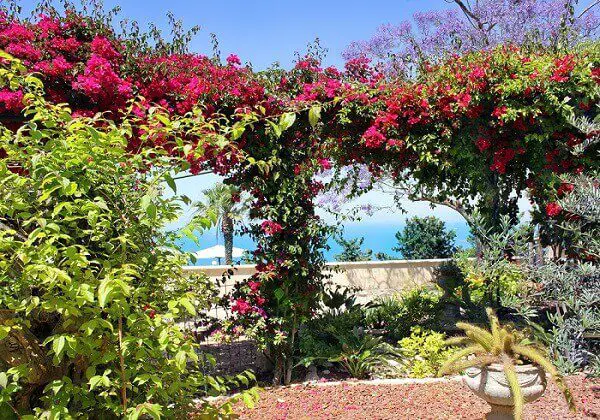
*This post contains affiliate links which means if you make a purchase we will be compensated.
Table of Contents
What is xeriscaping?
Xeriscaping is choosing drought resistant and native plants over water-dependent plants for the purpose of conserving water in areas that get little rainfall. This results in a landscape with little to no additional irrigation needs.
You can apply different levels of xeriscaping in your yard. If you’d like to do a small corner or a section, that’s always helpful for saving water.
For a more extensive water conservation practice, you could do a deep dive yard overhaul by using only water-tolerant plants and recycling rainwater.
** Great news!! : San Diego Utilities department will reimburse you for your rain barrel purchase
This rain barrel meets current San Diego Utilities requirements (** as of this publishing date ).
Though we don’t get consistent rain here in San Diego, when we do get it, it pours.
** Did you know? A 500 square foot rooftop surface (via the downspout) can capture 300+ gallons of rain water for every 1″ of rain that falls. That’s incredible!
Hundreds of gallons of FREE water for every inch that falls here — as long as you catch it. 😉
What is the purpose of xeriscaping?
Xeriscaping serves the purpose of reducing irrigation needs in yards and landscapes to conserve water in very dry climates that have scarce amounts of annual rainfall.
Unfortunately, residents of arid drought-prone areas use extreme amounts of water to sustain lawns and other thirsty-plant choices just where water conservation is most crucial.
What is the goal of xeriscaping?
The goal of xeriscaping is to prioritize the use of native and drought-tolerant plants in outdoor spaces to eliminate water waste and create sustainable habitats for local wildlife.
Xeriscaping doesn’t mean creating a desert-like outdoor space that’s void of color and lush foliage. Quite the opposite. When choosing water-wise plants and accents, a strong focus on beauty and diversity will thrill the senses and breathe new life into local pollinator populations.
Luckily, drought tolerant plants for San Diego number in the hundreds — at least.
You’ll find everything from beautiful flowering trees, vines, and shrubs to the unique colors and textures of succulents and ornamental grasses.
How does xeriscaping save water?
Drought-tolerant plants use far less water than their thirsty cousins. Xeriscaping makes good use of plants that are native to this area and are used to dry conditions.
Some San Diego native species need little to no irrigation.
They naturally use up stored soil moisture as needed over the season rather than requiring an entire watering cycle every few days.
We’ll also cover the use of beautiful non-native species that add color but still save on water later in the article.
By watering our yards less often and making good use of mulch around plants, we lose much less water from run-off and evaporation.
The EPA recommends using xeriscape landscaping to reduce water consumption by 30 percent.
The beauty of arid landscapes
Arid landscapes can be quite beautiful when various elements of interest are incorporated. Sometimes all it takes is opening our eyes to something different that’s outside of what we’re used to.
An arid design in your yard can be beautiful in a way that many other landscapes cannot emulate. Everyone knows how beautiful Italy and Spain are. The Mediterranean is an arid climate like ours and the beauty is undeniable.
There are many people who actually prefer to have an xeriscape garden that emulates our Mediterranean cousins.
The advantages of xeriscape gardening
Some of the many advantages to xeriscaping your garden area are:
- Saves you time and money by reducing maintenance.
- Saves you the trouble of wasting time on yard work on the weekends.
- It reduces your water bill — sometimes by a significant amount.
- A xeriscape yard can actually increase the value of your home if you live in a very drought-prone area.
- It’s much easier to maintain during drought conditions and eliminates stress when there are long periods of little moisture.
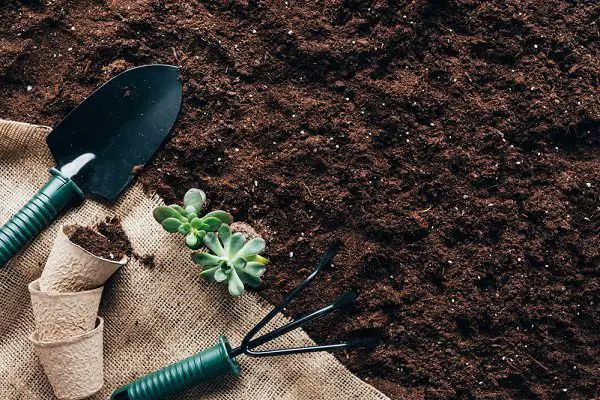
How to prepare for xeriscape landscaping
Before xeriscaping your yard, check the soil type to see if it needs improving depending on the plants you’re choosing. Some drought-tolerant plants want moisture retained near their roots and others will die if water won’t drain properly.
You’ll also need some type of irrigation to provide water for those that require a little. It doesn’t have to be fancy or expensive. The best irrigation choices won’t waste water and provide moisture right at the roots — and will slowly let water trickle in.
Improve your soil
A good bit of San Diego’s soil is dense clay (some areas have sandy/loamy soil). This means it may need to be amended for better drainage for plants that need very little moisture. Many drought resistant plants don’t mind poor soil, but most need good drainage to prevent root rot and overwatering.
Good soil amendments include:
- Perlite — good for clay soil and won’t hold moisture too long
- Peat moss — good for clay soil & helps aerate and drain
- Composted wood chips or bark — good for clay & adds drainage and permeability
- Peat, compost, vermiculite — good for sandy soil by helping retain moisture
You can add great drainage and water retention to our clay soil with perlite. It won’t change the PH of the soil but it does wonders for holding in more water and making the soil better for planting.
Other ways to improve clay soil for xeriscape plants are to add peat moss which allows water to flow freely and won’t keep it there, as well as composted wood chips and bark.
For sandy soil improvement, use materials that will hold onto a little more water (*only if the xeriscape plants don’t do well in sandy soil — check first) like compost and vermiculite.
Have an irrigation source
Before xeriscaping your area you’ll need an irrigation source. The more automated, the better. And since your plants are drought-tolerant, you won’t need a heavy watering schedule in the first place.
Easy irrigation includes a drip irrigation system, which delivers water directly to the root of the plant instead of spraying water all over your plants. This is efficient and saves water.
You can also use a soaker hose that easily lays around plants that need watering. They’re are easy to set up (require no assembly) and really do a great job slowly soaking water in at the root of the plants.
Many irrigation systems can be connected to a timer which can be very helpful for automating your watering schedule for what your xeriscape plants like best.
How to plan and design a xeriscape garden
To get some good ideas about xeriscape garden design , you can look up some design books or check out this great San Diego resource for water-smart gardens.
Pinterest is also a great place to get more ideas for design when you’re planning out your drought-tolerant garden or yard.
Other ways to get xeriscape garden ideas are simply to drive around and look at what other people have done. You can pick up some great ideas from simple things such as the placement of trees, shrubs and grasses in a garden design .
Now you’ll need a plan of action for your xeriscaping project in your yard. The first step to planning out your project is to make yourself a simple xeriscaping ” map “.
To do this, simply find a large sheet of paper and draw out your property on it. Then take a pencil and mark down where you want to put the trees, shrubs, flower beds and any other elements that are going to be in your xeriscape garden .
When you’re drawing out your xeriscape yard map, don’t forget to think about how all the parts of your garden are going to connect with each other.
The elements in a xeriscape landscape design should be arranged so that it’s balanced and looks good from the standpoint of curb appeal (and for your enjoyment especially).
Once you’ve made your xeriscape garden map in pencil, you can get ready to start putting it into a real plan for your property.
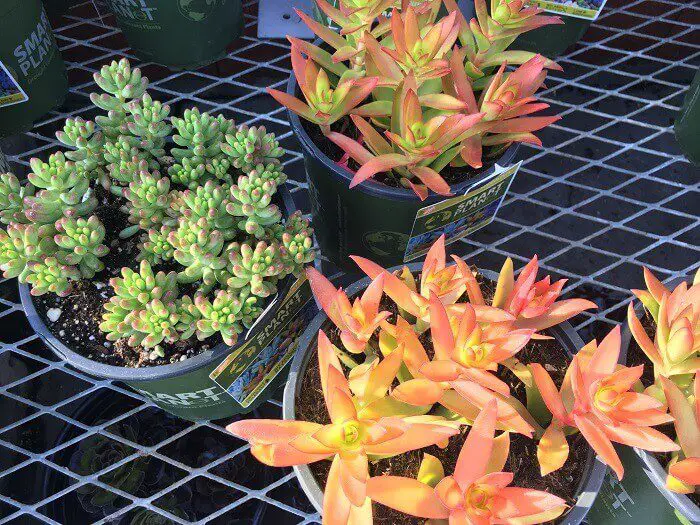
Using native plants
The best plants to start with for xeriscaping your yard are native plants. Native species can take the heat and drought much better than imported varieties because they’re adapted to our drought-prone climate here in San Diego.
Native plants are not only beautiful, but they also require less water, which saves you money!
Beside California native plants, xeriscaping with Mediterranean natives is also a great idea. The arid climate of that area mimics our San Diego climate, therefore, most plants that do well there, will thrive here as well.
There’s a larger section on Mediterranean plant choices below.
Bedding flowers for xeriscaping
Your low-water garden can still have color.
Many people have an aversion to xeriscaping because they envision a yard full of only cacti and succulents.
But drought-tolerant flowers such as begonia, impatiens, and violas can be put in the ground and do very well.
We’ll give you a long list of bedding flowers that do great with less water.
Incorporating these types of flowering plants in with your xeriscape design will provide a beautiful pop of color if that’s what you’re after.
You can also try some edibles and culinary herbs, which will add a bit of color, fragrance and flavor to your garden.
Drought-tolerant perennials
There are plenty of perennials that can add color to your xeriscaping.
Here are are few to consider. This is only a partial list. Check with your local garden nursery for more ideas.
- Foxgloves are stunning purple and yellow flowers that grow well in xeriscape gardens.
- Purple coneflower is a wildflower that blooms late into the season, so they give nice color for much of the year.
- Yarrow tolerates both heat and drought and comes in a variety of bright colors.
- Pineleaf penstemon offers tiny bright red flowers that are great for butterflies and hummingbirds.
- Russian sage is a very popular drought-tolerant flower known for its lovely silvery foliage and bright purple flowers.
- Salvia come in many varieties and also offer great color to a xeriscaped garden.
- Lavender is an amazing choice for dry and hot conditions. It smells out of this world and the bees really love it as well.
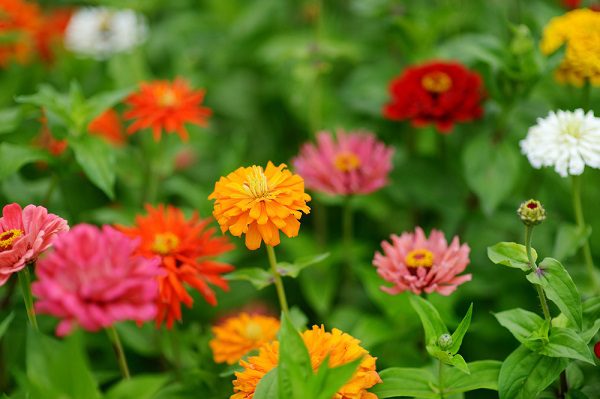
Drought-tolerant annuals
Here are some ideas for annual flowers that don’t require much water and would add color to a xeriscape design.
This is only a partial list. Check with your local garden nursery for more ideas.
- Zinnia is a pretty annual flower that does great in heat with low water. They come in a wide range of colors.
- Sunflowers add wonderful color and texture to a garden, love full sun and don’t need much water.
- Cosmos do very well in a xeriscape garden and offer a variety of colors.
- Vinca deserves a special mention as a great addition for drought-tolerant color in your garden or yard since it can also be used as a ground cover and can easily be incorporated into a rock garden area as well.
- Petunias come in a rainbow of colors and are also heat and drought tolerant.
Click here for a list of outstanding San Diego nurseries that can help you make the most of your xeriscape garden.
Succulents and cacti are also great for xeriscape gardening
When talking about xeriscaping in your yard, succulents and cacti are what most people think of.
And they’re totally not necessary to qualify your yard as a xeriscaped space, so let’s make that clear.
BUT …
There are SO MANY beautiful varieties — from alien-like flowers to unexpected colors and very eclectic textures — they can definitely create a bold statement in your yard, if you want to use them.
Succulents do very well with drought conditions as long as you don’t over water them! They come in a wide variety of sizes and shapes from ground covers and to large sized trees capable of surviving for decades in drought conditions with little water.
They come in a variety of colors too!
If you don’t have a lot of space on the ground for your xeriscaping, try potting a variety of succulents in gorgeous pots of all shapes and sizes. This will add plenty of interest and beauty.
Cacti can also add interest and various textures to a drought-tolerant landscape. There are many that grow colorful flowers as well. They’re definitely heat tolerant and need very little water.
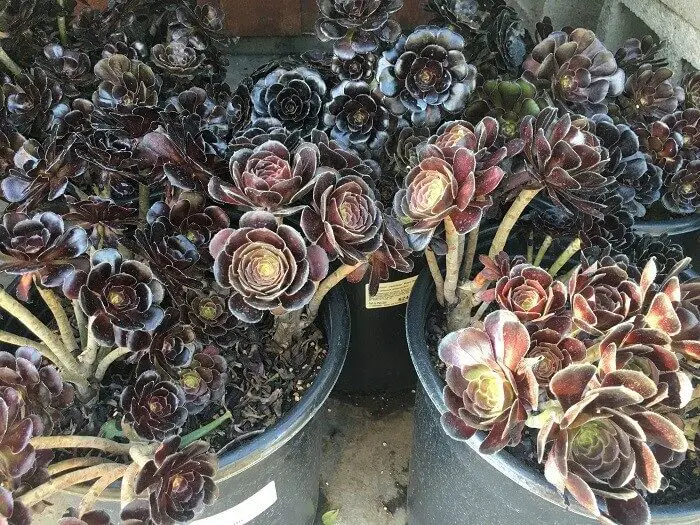
Mediterranean plants for xeriscaping
When you think of drought-tolerant plants, the Mediterranean region of the world has to be one of the first places you’d think of.
This area is practically defined by plants that are drought tolerant and have been cultivated for thousands of years in harsh conditions.
Popular Mediterranean plants include:
- Bougainvillea is our top vine choice for adding profuse color to xeriscaping. Train them on a trellis and they’ll certainly wow you!
- Rosemary is a Mediterranean native is known for its intoxicating smell, herbal uses in the kitchen, and surprising lovely blue flowers.
- Chives are beautiful spring blooming bulbs that add fragrance and color to your garden and will also add flavor to your cooking!
- Santolina offers fragrance and texture in your xeriscape garden with its pretty leaves that are grayish green in color.
Mediterranean trees that tolerate dry conditions:
- Arbutus is an evergreen tree has a gorgeous vase-like shape and tiny white flowers.
- Cherry Laurel has lovely pale pink dotting of spring blooms.
- Olive trees are a staple in the Mediterranean and can add interest (and olives) to your xeriscape yard.
- Lemon trees do very well in hot dry climates and they’re easy to keep happy with citrus spikes for slow, continuous feeding.
- Fig trees are also native to the drier climates of the world. Try a fig tree in your drought-tolerant landscape and enjoy the luscious fruit in late summer/early fall.
More great drought-tolerant plants for xeriscaping
- Butterfly weed
- Agave
- Gerbera daisy
- Cone flowers
- Coral vine
- Indian blanket
- Daylily
- Crown of thorns
- Lantana
- Marigolds
- Poppies
- Oleander
- Verbena
- Yellow Alyssum
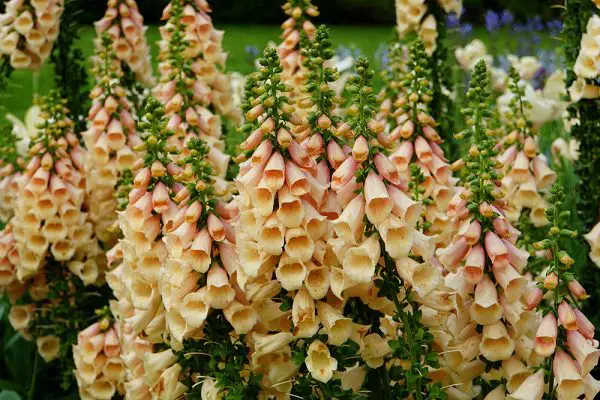
Drought-tolerant plants that attract bees
We all need to do our part to support dwindling numbers of honey bees, so this list of plants is specifically for them.
This is definitely only a partial list.
- Lavender is a literal mecca for bees. They love it.
- Bee Balm attracts bees with its fragrant leaves and flowers.
- Aster comes in many colors.
- Catmint can feed bees for many months (may attract some kitty visitors).
- Goldenrod are golden beauties that are great for attracting bees.
- Nasturtium comes in gorgeous colors and can be used as cascading or vine plantings.
- Zinnia are again a star of the xeriscape garden. Bees love these bright colored blooms.
- Ornamental onion are fast growing, tall, and offer round puff balls of star-shaped flowers. Great for drought and for bees.
- Dill and fennel are both packed with pollen and nectar and you can cook with them.
Rock gardens add interest to xeriscape landscapes
You can avoid feeling bored by your xeriscape garden by adding a rock garden or two.
If you’ve got plenty of rocks, this is an easy way to add interest and color to your xeriscaping.
If you need rocks, you can check local listings for free landscape materials on Craigslist or neighborhood networks like Nextdoor.
There’s always the local rock yard and garden center as well.
Stones and rocks are placed in a random pattern, with different concentrations of rocks in different corners of the garden.
Plants are added around these rocky nooks and crannies or cascading over them for a great display that adds height, color, and texture to a xeriscape design.
Rock gardening is an art. Use your creative side to arrange and plant to your heart’s content. For ideas on rock garden design you can also hit up Pinterest for inspiration.
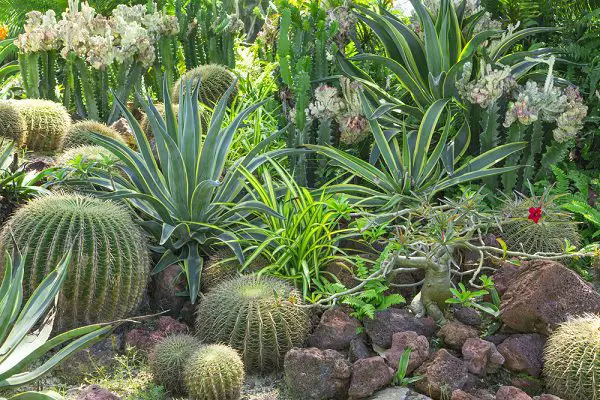
Drought-tolerant xeriscape shade gardens
It’s likely that your entire yard or garden isn’t full sun. Most of us have some shady areas as well.
There are drought-tolerant plants for the shade as well.
Drought tolerant plants for shade:
- Columbine have gorgeous multi-layered flowers, are easy to grow, and appreciate some shade.
- California honeysuckle has pink flower clusters and is very tolerant of shade and low water.
- African iris have great foliage and do well with some shade.
- Hardy fuchsia comes in stunning jewel-tone colors and is happy in the shade.
- Bleeding heart vines are great to add as climbers and do well in shady areas.
- Hardy begonia are also a great choice for shade and also add interesting foliage to the mix as they have red/pink leaves.
- Foxglove offers tall clusters of flowers in many different colors.
- Carpet geranium is a great choice for ground cover and is very hardy.
Best mulch for xeriscaping
Mulch is an important part of a xeriscaping for a garden. There are many different materials to choose from when deciding what kind of mulch you should use for your specific area.
A good way to use mulch in xeriscaping is to use it around tree trunks and plants.
** Be sure to check each individual plant’s preference for moisture retention. Some will not do well with mulch.
Mulch is a great way to help keep moisture in the soil of your drought-tolerant garden so none of the precious water goes to waste.
Wood chips are a great choice for xeriscape gardens.
Pine bark mulch is especially good because it’s widely available and helps with water retention as well as keeping your soil moist — which is especially important for drought-tolerant gardening plants.
These kinds of mulches are also very attractive by themselves because they look natural in the garden and won’t need much upkeep if any at all.
Mulch’s primary DOWN SIDE is the fading of the color over time. But there is a solution for that ugly faded color without spending tons of money replacing it every year.
Check out this clever and non-toxic solution for faded mulch that won’t require replacement.
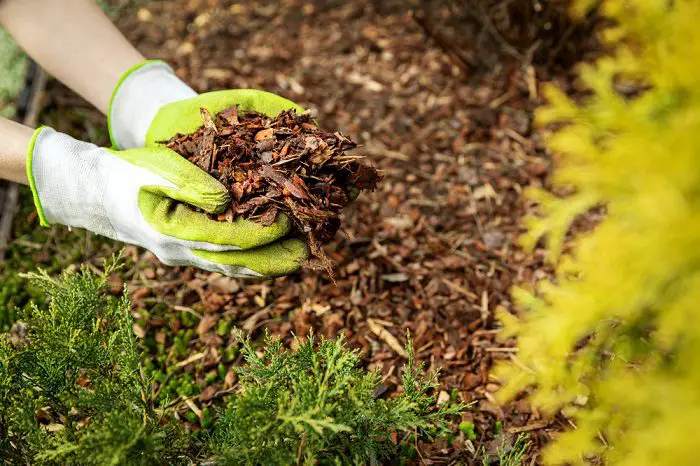
A word about gravel in a xeriscape garden
A very common misconception is that a drought-tolerant garden should involve a large amount of gravel. Xeriscaping doesn’t have to involve gravel at all.
Large amounts of gravel can actually do more harm than good with your plants — and it can be really ugly if that’s all you see.
Gravel and rock absorb heat and can make for thirstier plants as well as inconsistent soil temperatures. On a hot day, the soil underneath may not cool off until well into the night. This can cause some real stress for your plants and could actually kill some.
Gravel can also work its way into your soil and cause a disruption in soil quality. It also has no organic matter to break down and add to soil health.
So be cautious when considering gravel and small rock in your xeriscape garden planning.
It’s not necessary, but if you like the look of it, use it sparingly and maybe reserve it for walkways instead.
Lawn replacement ideas
What do you do when you love the green look of a lawn but you need drought-tolerant alternatives?
Drought-tolerant ground cover can give you the green you’re craving without being a water hog like traditional grass.
Great drought-tolerant ground cover choices
- UC Verde buffalo grass was bred and cultivated by the University of CA as a traditional grass replacement. It needs 75% less water and looks like a regular lawn.
- Ice plant is used widely in CA as a ground cover that’s very attractive and drought tolerant. It’s great on hillsides and places where you don’t need to walk.
- Dwarf carpet of stars may just be the perfect answer to a non-grass lawn in your xeriscaped yard! It’s technically a succulent but only grows 1-2″ in height and accepts heavy foot traffic no problem.
- Creeping thyme is also a great choice for adding green to your water-saving yard. The best part is its wonderful aroma and it also accepts foot traffic without being hurt.
Lawn Gone is a great resource for alternatives to water-sucking grass!
These next images are the Dwarf Carpet of Stars lawn-replacement mentioned above.
You’ll notice how soft it looks to walk on!
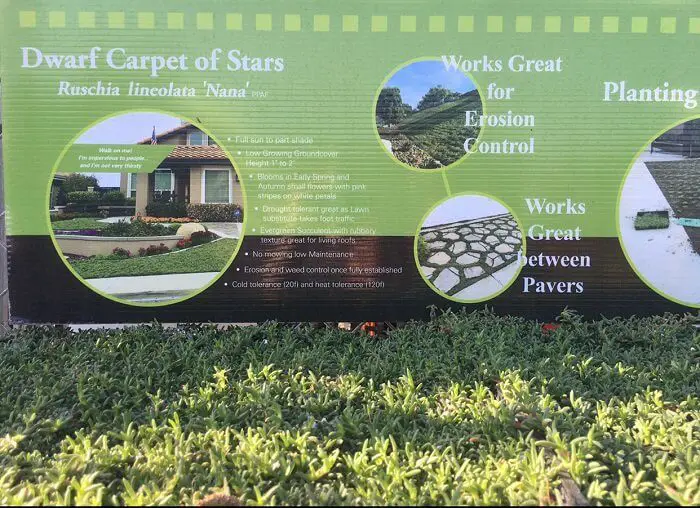
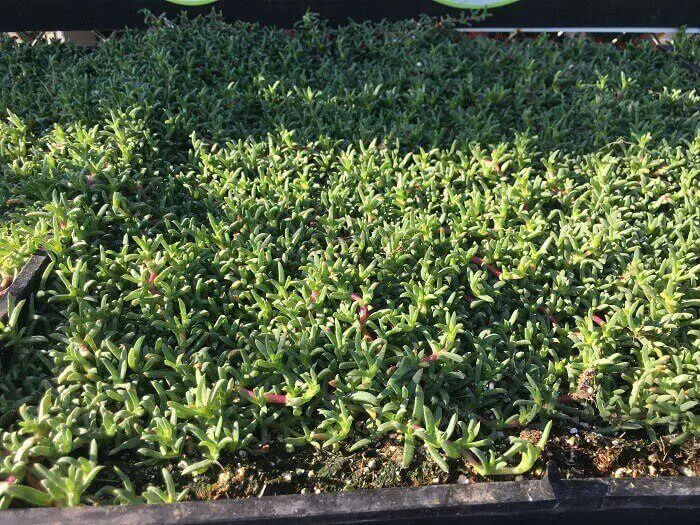
Native grasses are great in xeriscape yards
Native grasses can be a great addition to a drought-tolerant yard.
California fescue (Festuca californica) is a drought-tolerant native grass that thrives in full sun/part shade and has varying heights depending on the soil conditions.
Reed grass (Calamagrostis purpurascens) is a native grass that survives with little water and is drought-tolerant. This handsome grass can handle full sun/part shade and has varying heights depending on the soil conditions.
Leymus (Canyon Prince) is also considered a native grass to CA and needs very little water, especially during the first few years of growth. Just make sure you have plenty of space for this drought tolerant plant because it can grow 6′ or taller!
Field sedge (Carex) is a native grass that’s drought-tolerant, can handle full sun/part shade, and has varying heights depending on the soil conditions.
Hardscaping for a special touch to a xeriscape garden
Your newly-planted water-wise yard wouldn’t be complete without some points of interest and functional elements.
Pathways, water features, lighting, and other elements are what we call “hardscape” features. They add a lot of charm and value to any landscaping project.
Walkways in your garden
In addition to the living elements of your xeriscape garden, you’ll want to incorporate some walkways that can help define the look of your xeriscape garden.
There are different materials you can use for garden walkways based on your needs and the budget you have available.
For a less expensive option, you can use gravel or various types of rock to design attractive pathways to walk through your garden.
Flagstone is a beautiful option for walkways as well. It’s more expensive than rock, but adds an elegant touch.
If your xeriscape garden is in a sunny location, it’s important to consider what the color and texture of these materials will be like over time.
Do they hold up well if exposed to sunlight for long periods? Also consider if you’d like your path to stand out or blend in more with the overall xeriscape look of your garden.
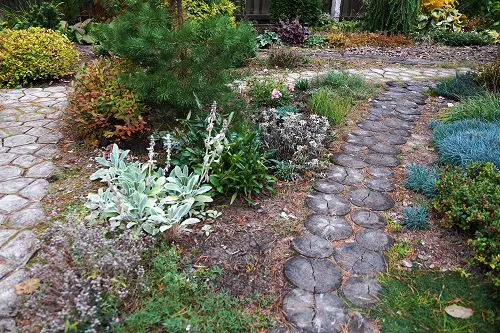
Mix things up with beautiful containers
No garden would be complete without at least a few containers or pots. Potted plants make a great addition to a xeriscape garden.
PLUS —
Modern minimalist style pots don’t have to break the bank — or YOUR BACK!
These beautiful pots are made with recyclable plastic and natural stone powders.
Benefits of adding pots to your xeriscape garden:
- Flower pots can be found in just about any size, color, shape, and material you can imagine.
- You can easily move them around the garden or yard depending on your mood or the season.
- Most containers hold moisture well and are perfect for growing drought-loving plants.
- Be aware that terra cotta pots need to be glazed on the inside for best moisture retention.
- Almost any flowering plant, bush — or vegetable, for that matter — can be happy in a pot.
Be sure to check with your local nursery before making your final choices to make sure they are good to go in a pot.
Find the best nurseries near you here in our extensive San Diego nursery guide.
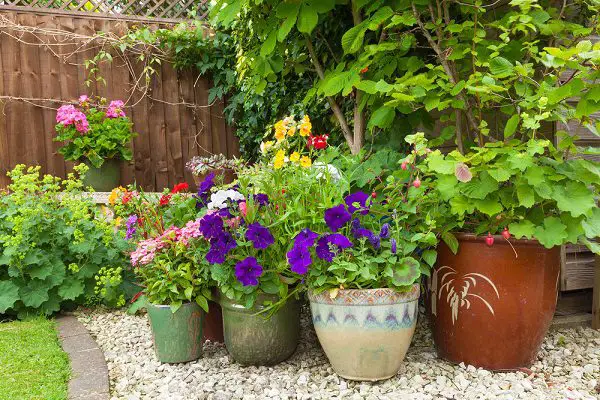
Lighting is the finishing touch in a xeriscape garden
You now have this amazing garden filled with water-saving plants … CONGRATULATIONS!
Let’s brighten things up a bit with garden lighting so your xeriscape yard has massive curb appeal and ambiance.
Outdoor landscape lighting ideas
- Pathway lighting helps you find your way at night and adds a stellar element of tranquility. Solar-powered LED garden lights are made to last and use the power of the sun … a WIN-WIN!
- Ground lighting adds a soft glow to flat surfaces as well as any features with water.
- Decorative lighting which could light up interesting architectural features in and around your xeriscape garden so they’re just as fantastic at night as during the day. Warm LED landscape lights are great for highlighting a special tree, path, or striking garden element.
- And my favorite garden lighting are strings of lights that can be hung on a fence line, an arbor, under a lattice overhang … the sky’s the limit.
Imagine a simple arbor covered with bougainvillea — a table just beside it — and lights strung around the tops of the lattice and arbors.
BEWARE — Creating such a magical space may lead to very long dinners and guest who won’t leave. Don’t say we didn’t warn ‘ya!!
Xeriscape gardens in conclusion
A drought-tolerant yard here in San Diego doesn’t have to look barren and ugly.
And it certainly doesn’t need 1000 pounds of gravel to prove that it’s a xeriscape garden!
Use some of our pointers + your own creative touch, and build the gorgeous xeriscape garden of your dreams. Your water bill will thank you!
You’ll also enjoy these other articles in our gardening series
- San Diego Xeriscape Gardens
- Drought Tolerant Plants for San Diego
- San Diego Ground Cover Plants
- The Best Nursery in San Diego
- San Diego Palm Trees and How to Care for Them
- Best Wholesale Nurseries
